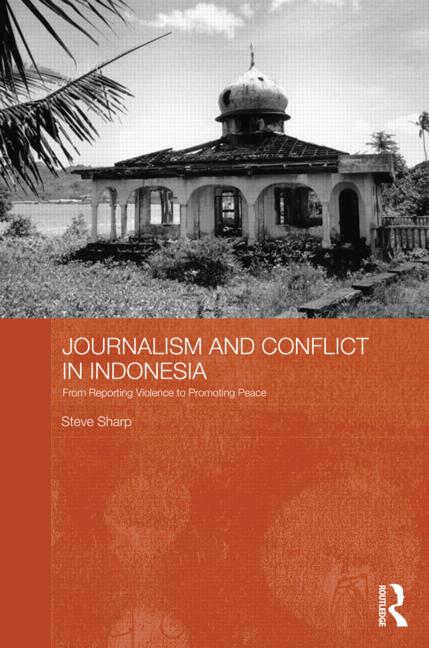A new book opens up debate about the power of the journalist and media organisations reporting conflict in Indonesia
Ross Tapsell
In an effort, perhaps, to practice what his book, Journalism and conflict in Indonesia: From reporting violence to promoting peace preaches, author and journalist Steve Sharp now runs his own media company (www.telingamedia.com) out of Townsville. The site includes content from eastern Indonesia to the South Pacific and describes its mission as more far reaching than simply that of providing news: ‘Knowing each other will bring us together – on our own terms. As we float in a sea of mutual ignorance and confusion, telingamedia.com swims against the tide.’
Sharp’s new book is a study of print media coverage of conflict in Indonesia with a particular emphasis on the region of Maluku in the years 1999-2001, when as many as 9000 people are estimated to have died. The research focuses on an important period of Indonesia’s history of ‘transition’ from authoritarian regime to democracy. It is the story of journalism and the conflict in Maluku that is without doubt the most interesting and unique contribution the book makes, showing us what the newspapers were reporting at the time of conflict.
The book opens up debate about the role of media practitioners in pursuing accurate rather than inflamed coverage of such conflict. Sharp looks to illustrate how the Indonesian mainstream print media has the capacity to escalate violence, or to alternatively adopt practices which might better promote peace. He argues that ‘peace journalism’, where the media are involved in assisting with ‘conflict resolution’, is the solution. This is the opposite of ‘war journalism’, which focuses on the reporting of violence and who is winning or losing. It involves media production processes being rearranged so that deeper causes and effects of violence are explained. In the Maluku case, Sharp writes, peace journalism means ‘understanding volatile centre-periphery politics’, and can be achieved by encouraging journalists to resolve conflict through specific media management and training strategies.
Like many major academic studies, Journalism and conflict in Indonesia is an adaptation from a doctoral thesis; in this case a 2011 PhD completed at Griffith University. The challenge of converting a thesis to a book is evident in its early chapters and, for any early career researcher looking to publish their PhD, is worth analysing. The opening account sets up the book’s aims, which are to examine the ‘capacity for media narratives to contribute to the escalation of violent conflict’. What follows in the early chapters are comprehensive literature reviews of existing work in the field, which while well researched might cause readers to find themselves wanting to get to the more engaging new material Sharp presents here about the war in Maluku.
Journalism and conflict presents two main critiques of the reporting of conflict in Maluku. The first is that the conflict was subjected to a ‘primordialist media narrative’. Sharp defines ‘primordialism’ as ‘a strong sense of group identity based on some primary form of affiliation’. He explains that, rather than offering consistent alternative readings, the reporting in Kompas and Republika ‘became vehicles for mining a far simpler and accessible corner of national historical memory – base religious primordialism’. Sharp contends that in both newspapers, the reports ‘facilitated the militants’ war communication’ and contributed to the escalation of violence.
Sharp’s second critique is that the reporting was Jakarta-centric, with ‘talking heads’ expressing partisan political feuding far away from the battlefront. He found there were few reports originating ‘on the ground’ where the conflict was occurring. This is unsurprising given that Sharp’s research does not include textual analysis of local news media. Instead, he analysed reports from Kompas and Republika, two newspapers based in the capital. Sharp concludes that ‘the media’s failure to address shifting power relations between political elites in Jakarta and Maluku was a spectacular failure of journalism that did nothing to assist a negotiated peace and may have contributed to the war’s significant escalation’.
The book’s main title Journalism and conflict in Indonesia is in keeping with the recent trend of broad titles at Sharp’s publisher, Routledge. Would it really have made much of a difference to sales if the more accurate word ‘Maluku’, was somewhere in the title of this book? Presumably the answer is yes. There are two main problems with this ‘policy’ of broad titling. First, we are faced now with similar titles on media and journalism in Indonesia. David T. Hill's biography of Mochtar Lubis, broadly entitled Journalism and politics in Indonesia (2012) and perhaps even Hill’s and Krishna Sen's book Politics and the media in twenty first century Indonesia (2011) are two recent examples. The second, and far more compelling concern with regards to this book, is that the generic title suggests Sharp’s primary research encompasses coverage of a variety of conflicts in the Indonesian archipelago. ‘Conflict’ in this book is predominantly the Maluku violence of 1999-2001 and ‘journalism’ is seen through the lens of reports in two Jakarta dailies.
Indonesia’s media have evolved considerably since the Maluku conflict, both at a regional and national level. The Press Council, media ombudsmen, journalistic unions and even media practitioners themselves have seemingly reduced the capacity for fervent ‘primordialist media narrative’ of conflict and violence. This is not to say it will not rear its ugly head in the future, but overall the advancement in professional journalism in Indonesia since the immediate years following reformasi has been encouraging for those of us who monitor the Indonesian media. As larger multi-platform conglomerates become a feature of the Indonesian media landscape, media narratives in the archipelago are likely to become increasingly Jakarta-centric. In this regard, Sharp’s work is important in showing the consequences of what he describes as ‘local political conflict traceable to Jakarta’.
Steve Sharp, Journalism and conflict in Indonesia: From reporting violence to promoting peace, Routledge, London, 2012.
Ross Tapsell (ross.tapsell@anu.edu.au) is a lecturer in Asian Studies at the Australian National University.












